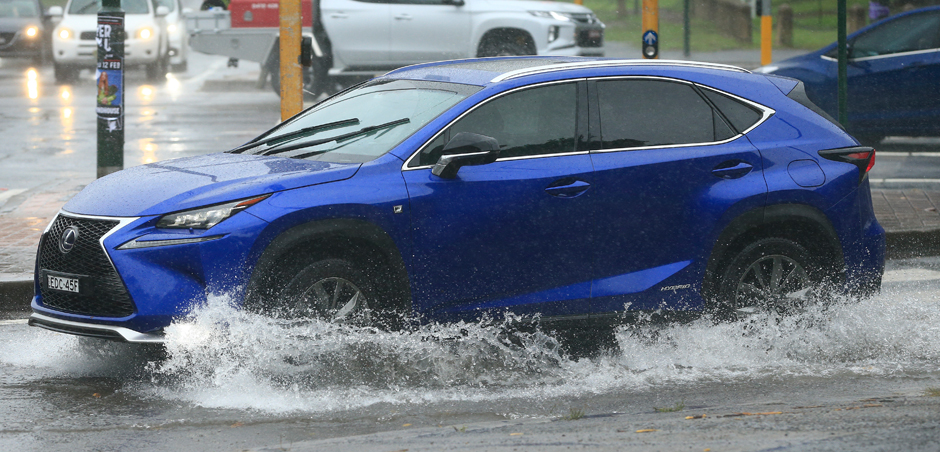 -By Erie Insurance
-By Erie Insurance
Imagine that you’re driving down the road, minding your own business, when out of nowhere a torrential storm hits. Rain pounds relentlessly on your windshield, making it nearly impossible to see. Several of your fellow drivers slow down or turn on their hazards while others pull over to wait it out.
As you try to navigate, there’s another — sometimes forgotten — hazard to look out for: flash flooding.
Every season is flash flood season. But are you prepared? Here, we break down the basics of what you should know about this dangerous phenomenon and how you — and your vehicle — can stay safe while riding out the storm.
WHAT IS A FLASH FLOOD?
Flash floods are sudden, local floods that are usually caused by heavy rainfall. They can occur within minutes or a few hours after the rain starts falling. A burst dam or levee, or a released ice jam, can also create this type of flooding.
WHERE DO FLASH FLOODS OCCUR?
Floods can occur anywhere and anytime, even in places you may not expect them. In many instances, the ground just can’t absorb the volume of rain that is pouring down. Streams, rivers and dry creeks can also swell and become prime spots for flash floods.
WHAT SHOULD I DO IF I COME ACROSS A FLOODED SECTION OF ROAD?
If you approach any kind of flooding, including large puddles of groundwater, your safest action is to turn around and find another route.
What may not seem like a lot of water can in fact be quite dangerous when you’re behind the wheel. It can be hard to gauge how deep the water is, and you can’t see what dangers may be below the water, such as debris or other hazards.
When it comes to fast-moving, rushing flood water:
- 6 inches of water can stall a vehicle or knock over an adult.
- 1 foot of water can sweep away a small car.
- 18 to 24 inches of water can carry off a truck, van or SUV.
This should go without saying, but never drive around a barricade or a “road closed” sign.
WHAT SHOULD I DO IF MY VEHICLE IS SWEPT AWAY BY A FLASH FLOOD?
If you’re ever driving on a flooded road and your car stalls, abandon it immediately and move to higher ground. To escape a flash flood, follow these instructions from the American Safety Council:
- Stay calm and stay off your phone. Take a deep breath, don’t panic and immediately start taking action to get yourself—and your passengers—out of your vehicle swiftly and safely. Right now, 911 can wait.
- Unbuckle your seat belt. If you have a child riding with you, tell them to do the same. You may need to help younger children.
- Roll down your windows and swim out. The pressure of the water against your vehicle will make it extremely difficult to open your door. If you can’t open your window, break it open by using a sharp object such as an umbrella, a rock, a screwdriver or the heel of your shoe to hit the center of your window. Kicking open the window is another option, but it’s extremely hard to do. Aim for the upper right corner of a side or door window – that’s often a window’s weakest point.
- Swim with the flow of water. Don’t hang onto your vehicle. Instead, travel with the water until you can climb onto higher ground and get help. Once you are out of the water, stay out. Keep an eye out and steer clear of any downed power lines, which are extremely dangerous.
- Wait for your vehicle to sink. This should only be done if you’re trapped in your vehicle and have no other options. It should be your last resort. Your doors won’t open until the pressure outside your vehicle matches the pressure inside your car. So, unlock your doors and take slow, deep breaths. Once water has filled the vehicle, take one final deep breath, open your door and swim out, bringing along any passengers in your car. Once everyone is out, kick off your vehicle for an extra push to rise to the surface.
WHAT SHOULD I DO IF I COME INTO CONTACT WITH FLOOD WATER?
After you’ve reached safety, clean any area that came into contact with flood water as soon as you can. Ideally you should scrub up with soap and clean water. Hand sanitizer or alcohol-based wipes can also work in a pinch. This would be a good time to visit; What to Include in a Car Emergency Kit by ERIE INSURANCE.
A host of contaminants can lurk beneath the surface of the water, including human or animal waste, animals like rats and snakes, and household and industrial waste. These can cause skin rashes, infections and other illnesses. If you have any cuts or injuries, make sure you clean them thoroughly and get medical help if you need it.
WHAT KIND OF DAMAGE CAN DRIVING THROUGH A FLOOD DO TO MY VEHICLE?
If you make it out of a flood without significant damage to your vehicle (or even totaling it entirely), consider yourself lucky.
Water can damage or destroy your vehicle’s engine, transmission and other critical components to the point where you can’t operate it anymore. It can also cause irreversible damage to your car’s complex electrical system. Because of this long-lasting damage, flooded vehicles are often considered a total loss by insurance providers.
Beware that there are some dishonest auto dealers who will purchase vehicles (new and used) from flooded areas, clean them up and try to resell them with the flood damage illegally hidden. So, when you shop for a new or used vehicle, be on the lookout for this shady practice. Also, take a few minutes to read about How to Know if a Vehicle Has Flood Damage on Erie Insurance website.
WILL MY INSURANCE POLICY COVER THE COST OF FLOOD DAMAGE TO MY VEHICLE?
Comprehensive coverage, which is optional, can typically cover flood damage. Without it, you’ll most likely have to cover the cost of a new vehicle yourself. Learn more about auto insurance and what else it can cover.
FIND A FRIEND FOR WHEN TROUBLE HITS
Whether it’s a stalled truck on a flooded highway or a fender bender in town, when you run into a problem with your vehicle, it’s easy to feel stranded.
Assure America offers a variety of insurance options for businesses such as Property and Contents, Business Interruption, General and Professional Liability, Workers Compensation and Employer Liability, Products and Completed Operations, Boiler and Machinery, Automobile Liability, Inland Marine, and Fidelity and Surety Bonding. Contact one of our professionals at Assure America. We have locations in: Weirton, Wellsburg and Chester in West Virginia; Steubenville, Ohio; Louisville, Kentucky; and Pittsburgh, Pennsylvania.



Post Your Comment